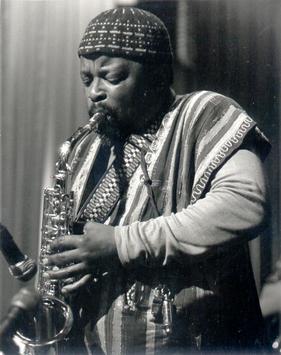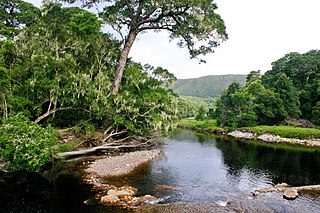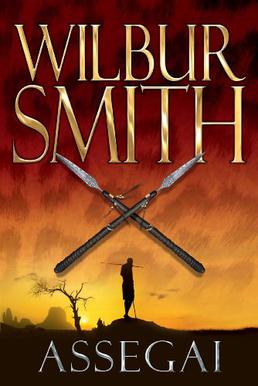
Napoléon, Prince Imperial, also known as Louis-Napoléon, was the only child of Napoleon III, Emperor of the French, and Empress Eugénie. After his father was dethroned in 1870, he moved to England with his family. On his father's death in January 1873, he was proclaimed by the Bonapartist faction as Napoleon IV.

Curtisia dentata is a flowering tree from Southern Africa. It is the sole species in genus Curtisia, which was originally classed as a type of "dogwood" (Cornaceae), but is now placed in its own unique family Curtisiaceae.

Wilbur Addison Smith was a Northern Rhodesian-born British-South African novelist specialising in historical fiction about international involvement in Southern Africa across four centuries.

Mthutuzeli Dudu Pukwana was a South African saxophonist, composer and pianist.
Mongezi Feza was a South African jazz trumpeter and flautist.

An assegai or assagai is a pole weapon used for throwing, usually a light spear or javelin made up of a wooden handle and an iron tip.
Assagai was an Afro-rock band, active in the early 1970s in London, whose relatively short career produced two albums recorded in 1971. It has been described as "the second best-known African group of the late 60s/early 70s in Britain" after Osibisa.
Witch smellers, almost always women, were important and powerful people amongst the Zulu and other Bantu-speaking peoples of Southern Africa, responsible for rooting out alleged evil witches in the area, and sometimes responsible for considerable bloodshed themselves. In present-day South Africa, their role has waned and their activities are illegal according to the Witchcraft Suppression Act, 1957.
Afro rock is a style of rock music with West African influences. Afro rock bands and artists in the late 1960s and early 1970s included Osibisa, Assagai and Lafayette Afro Rock Band.

The Knysna–Amatole montane forests ecoregion, of the tropical and subtropical moist broadleaf forests biome, is in South Africa. It covers an Afromontane area of 3,100 square kilometres (1,200 sq mi) in the Eastern Cape and Western Cape provinces.
Zimbabwe is a country in southern Africa.

Assegai is Wilbur Smith's thirty-second novel, it follows The Triumph of the Sun in which the author brought the Courtney and Ballantyne series together. Assegai tells the story of Leon Courtney and is set in 1906 in Kenya. The events in the story are linked to and precede the outbreak of World War One.
The Courtney Novels are a series of seventeen novels published between 1964 and 2019 by Wilbur Smith. They chronicle the lives of the Courtney family, from the 1660s through until 1987. The novels can be split into three parts; the original trilogy of novels follow the twins Sean and Garrick Courtney from the 1860s until 1925. The second part is five books which follows Centaine de Thiry Courtney, her sons and grandchildren between 1917 and 1987. The third part, the most recently written, follows the Courtney family from the 1660s through until 1939, focusing on successive generations of the family. There are also two books that follow the third series. As well, there are three additional Courtney books.

Southern Afrotemperate Forest is a kind of tall, shady, multilayered indigenous South African forest. This is the main forest-type in the south-western part of South Africa, naturally extending from the Cape Peninsula in the west, as far as Port Elizabeth in the east. In this range, it usually occurs in small forest pockets, surrounded by fynbos vegetation.

Cecilia is a section of the Table Mountain National Park on the lower eastern slopes of Table Mountain in Cape Town, located just to the south of Kirstenbosch National Botanical Garden. It was previously used for commercial logging and known as Cecilia Forest or Cecilia Plantation, but has now been given protected status and integrated into the National Park.

Willem Steenkamp is a South African author, journalist, historian, military analyst and citizen soldier. He has published a number of books and consults widely in military affairs.

Maesa lanceolata, the false assegai, is a tree species that is widespread in the Afrotropics, including Madagascar. It occurs from the southern Arabian Peninsula, southwards to the Eastern Cape, South Africa. It grows on stream verges, river banks and forest verges, where it is often a pioneer plant.

111 Battalion was a motorised infantry unit of the South African Army.
Anthony Kotze, referred to in some sources as Anthony Kotzé, was a racing driver and racing car constructor from South Africa. He participated in four non-championship Formula One races and several sports car races, and is perhaps best known as the constructor of the Assegai, one of the only South African-built Formula One cars.

The Assegai was a Formula One car built by Tony Kotze under the marque Bond Cars. It was named after an African spear. It was entered for two non-championship Formula One races and various club-level races in South Africa. The Assegai and the LDS are the only Formula One cars to have been built by South African constructors.












